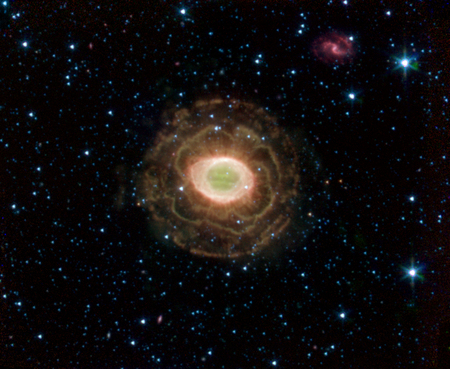Infrared Ring Nebula

Creator: Spitzer Space Telescope, Pasadena, CA, USA
Image Source: http://www.spitzer.caltech.edu/images/1403-ssc2005-07a1-Infrared-Ring-Nebula
NASA's Spitzer Space Telescope finds a delicate flower in the Ring Nebula, as shown in this image. The outer shell of this planetary nebula looks surprisingly similar to the delicate petals of a camellia blossom. A planetary nebula is a shell of material ejected from a dying star. Located about 2,000 light years from Earth in the constellation Lyra, the Ring Nebula is also known as Messier Object 57 and NGC 6720. It is one of the best examples of a planetary nebula and a favorite target of amateur astronomers.
The "ring" is a thick cylinder of glowing gas and dust around the doomed star. As the star begins to run out of fuel, its core becomes smaller and hotter, boiling off its outer layers.
The telescope's infrared array camera detected this material expelled from the withering star. Previous images of the Ring Nebula taken by visible-light telescopes usually showed just the inner glowing loop of gas around the star. The outer regions are especially prominent in this new image because Spitzer sees the infrared light from hydrogen molecules. The molecules emit infrared light because they have absorbed ultraviolet radiation from the star or have been heated by the wind from the star.
Image Use Policy: http://www.spitzer.caltech.edu/info/18-Image-Use-Policy
View Options
Image Details
- Image Type
- Observation
- Object Name
- Ring Nebula • Messier 57 • M57 • NGC 6720
- Subject - Milky Way
- Nebula » Type » Planetary
Position Details

- Position (ICRS)
- RA = 18h 53m 34.8s
- DEC = 33° 1’ 37.9”
- Orientation
- North is 15.7° CCW
- Field of View
- 10.7 x 8.8 arcminutes
- Constellation
- Lyra
Color Mapping
| Telescope | Spectral Band | Wavelength | |
|---|---|---|---|

|
Spitzer (IRAC) | Infrared (Near-IR) | 3.6 µm |

|
Spitzer (IRAC) | Infrared (Near-IR) | 4.5 µm |

|
Spitzer (IRAC) | Infrared (Mid-IR) | 5.8 µm |

|
Spitzer (IRAC) | Infrared (Mid-IR) | 8.0 µm |







